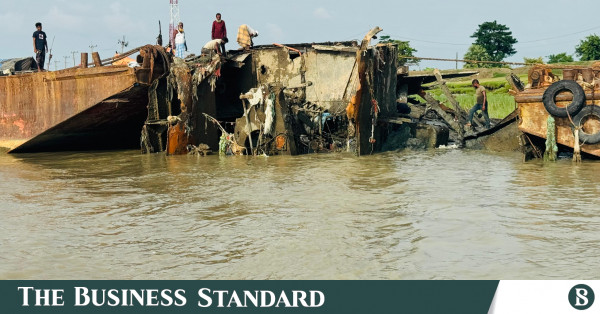Relics under Karnaphuli: Nameplate sheds light to ship’s Victorian-era past


On 17 August, the Hiramoni Salvage team recovered a steam-powered relic from beneath the silt and murky waters of the Karnaphuli River in Chattogram. The vessel, which is almost 150 years old, was part of the Revenue Survey Department attached to Oudh Province, now in modern-day Uttar Pradesh, India. Among the several relics that were found inside the vessel, the photos are of the nameplate, top left, with English, Urdu and Hindi inscriptions of the British Revenue Survey Department, that eventually revealed the identity of the vessel, the five silver coins, top right, from the 1862 Victorian era, and the salvaged vessel, bottom, from during the reign of Queen Victoria between 1856 and 1901. PHOTO: TBS
“>
On 17 August, the Hiramoni Salvage team recovered a steam-powered relic from beneath the silt and murky waters of the Karnaphuli River in Chattogram. The vessel, which is almost 150 years old, was part of the Revenue Survey Department attached to Oudh Province, now in modern-day Uttar Pradesh, India. Among the several relics that were found inside the vessel, the photos are of the nameplate, top left, with English, Urdu and Hindi inscriptions of the British Revenue Survey Department, that eventually revealed the identity of the vessel, the five silver coins, top right, from the 1862 Victorian era, and the salvaged vessel, bottom, from during the reign of Queen Victoria between 1856 and 1901. PHOTO: TBS
The identity of the ship recovered from the Karnaphuli River has been unearthed.
The vessel, dating back to the reign of Queen Victoria between 1856 and 1901, was part of the Revenue Survey Department attached to Oudh Province, now in modern-day Uttar Pradesh, India.
It was a vital tool for British officials, who used it to traverse the subcontinent’s waterways, surveying and collecting taxes for the central government.
On 17 August, after eight months of meticulous efforts, the Hiramoni Salvage team raised the steam-powered relic from beneath the silt and murky waters of the river in Chattogram.
Photo: TBS
“>
Photo: TBS
The ship’s identity remained a mystery until Hiramoni Salvage recovered a nameplate from its corroded hull.
“We knew from the beginning that this ship was over 100 years old, but its origins were unclear,” said Jihad Hosen, director of Hiramoni Salvage. “The nameplate confirmed it – a British-era ship, at least 150 years old.”
The nameplate, inscribed in English, Hindi and Urdu, bore the markings of the British Revenue Survey Department, linking it definitively to Oudh state.
Photo: TBS
“>
Photo: TBS
This multilingual engraving is reflective of the diverse and complex nature of British administration in India during the Victorian era.
“The ship likely sank in the late 19th century,” Jihad speculated, hinting at the mystery that still surrounds its demise. What was clear, however, was its significance in a period marked by industrial advancements, such as the steam engine, which revolutionised transportation and commerce across continents.
Sarker Protick, a historian with a keen interest in British-era artefacts, underscored the importance of the find.
“The era of Queen Victoria was a defining chapter in British rule over the Indian subcontinent. The steam engine powered an industrial revolution in Europe, and its influence extended here, leading to the establishment of the railway network. Before railways, waterways were the lifeblood of transportation, and ships like this one were a common sight at Chattogram Port,” Protick explained.
Protick also emphasised the need to preserve such historical treasures, suggesting the creation of an archive to document and protect the region’s rich heritage for future generations.
The ship was discovered near Dangarchar Ghat in the Chattogram Port channel, clearing the path for vessel movements.
Under the terms of an agreement with the Chittagong Port Authority, the recovered vessel and its contents became the property of Hiramoni Salvage, a company with a history of uncovering sunken ships and the stories they hold.
Alongside the ship, the salvage team unearthed a treasure trove of artefacts, each telling its own story of a bygone era. These included five silver coins from 1862, a lamp from the esteemed 18th-century Hykings Company, brass plates and glasses, intact wine bottles with remarkably preserved corks, a binocular, and candle holders.
The pristine condition of these items, especially the wine bottles, has sparked particular interest. “The corks are so well preserved that water never seeped through,” Jihad marvelled.
The discovery has piqued the interest of the British Museum, which is keen to acquire these antiques. “We’ve reached out to them, though we’re still waiting for a response,” Jihad noted, adding that such artefacts could fetch high prices at auctions in the UK.
Hiramoni Salvage is no stranger to significant finds. The company has recovered over 100 sunken ships across Bangladesh, including a World War II fighter jet from the Bay of Bengal near Banshkhali in Chattogram. But this latest discovery – a relic from a pivotal era in history – may be among its most meaningful.
As the Karnaphuli River continues to yield up its secrets, the recovery of this Victorian-era ship offers a window into the past, connecting the present to a time when the British Empire’s reach extended across the globe, leaving indelible marks on the lands and people it touched.
This ship, once a tool of empire, now serves as a reminder of the complex history that shaped the Indian subcontinent and the enduring legacy of the era of Queen Victoria.




